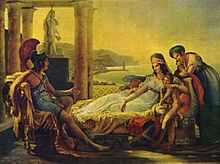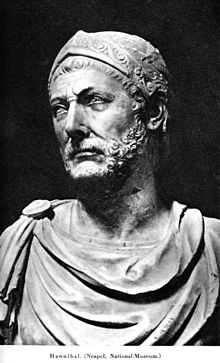Hanno the Navigator
Hanno the Navigator[1] was a Carthaginian explorer of the sixth or fifth century BC,[2] best known for his naval exploration of the western coast of Africa. The only source of his voyage is a Greek periplus.
Expedition
Carthage dispatched Hanno at the head of a fleet of 60 ships to explore and colonize the northwestern coast of Africa.[3] He sailed through the straits of Gibraltar, founded or repopulated seven colonies along the African coast of what is now Morocco, and explored significantly farther along the Atlantic coast of the continent. Hanno encountered various indigenous peoples on his journey and met with a variety of welcomes.
At the terminus of Hanno's voyage, the explorer found an island heavily populated with what were described as hirsute and savage people. Attempts to capture the males failed, but three of the females were taken. These were so ferocious that they were killed, and their skins preserved for transport home to Carthage. The skins were kept in the Temple of Tannit on Hanno's return and, according to Pliny the Elder, survived until the Roman destruction of Carthage in 146 BC, some 350 years after Hanno's expedition.[4] The interpreters travelling with Hanno called the people gorillae, and when European explorers first encountered gorillas in the 19th century, the apes were given this name on the assumption that they were the "people" Hanno described.
In its inmost recess was an island similar to that formerly described, which contained in like manner a lake with another island, inhabited by a rude description of people. The females were much more numerous than the males, and had rough skins: our interpreters called them Gorillae. We pursued but could take none of the males; they all escaped to the top of precipices, which they mounted with ease, and threw down stones; we took three of the females, but they made such violent struggles, biting and tearing their captors, that we killed them, and stripped off the skins, which we carried to Carthage: being out of provisions we could go no further.
Periplus account
The primary source for Hanno's expedition is a Greek periplus, supposedly a translation of a tablet Hanno is reported to have hung up on his return to Carthage in the temple of Ba'al Hammon, whom Greek writers identified with Kronos. The full title translated from Greek is The Voyage of Hanno, commander of the Carthaginians, round the parts of Libya beyond the Pillars of Heracles, which he deposited in the Temple of Kronos. The text was known to Pliny the Elder and Arrian, the latter mentioning it at the end of his Anabasis of Alexander VIII (Indica):
Moreover, Hanno the Libyan started out from Carthage and passed the Pillars of Heracles and sailed into the outer Ocean, with Libya on his port side, and he sailed on towards the east, five-and-thirty days all told. But when at last he turned southward, he fell in with every sort of difficulty, want of water, blazing heat, and fiery streams running into the sea.[5]
Warmington suggests[6] that difficulties in reconciling the account's specific details with present geographical understanding are consistent with classical reports of Carthaginian determination to maintain sole control of trade into the Atlantic.
This report was the object of criticism by some ancient writers, including the Pliny the Elder, and in modern times a whole literature of scholarship has grown up around it. The account is incoherent and at times certainly incorrect, and attempts to identify the various places mentioned on the basis of the sailing directions and distances almost all fail. Some scholars resort to textual emendations, justified in some cases; but it is probable that what we have before us is a report deliberately edited so that the places could not be identified by the competitors of Carthage. From everything we know about Carthaginian practice, the resolute determination to keep all knowledge of and access to the western markets from the Greeks, it is incredible that they would have allowed the publication of an accurate description of the voyage for all to read. What we have is an official version of the real report made by Hanno which conceals or falsifies vital information while at the same time gratifying the pride of the Carthaginians in their achievements. The very purpose of the voyage, the consolidation of the route to the gold market, is not even mentioned.
Modern analysis of the route

A number of modern scholars have commented upon Hanno's voyage. In many cases, the analysis has been to refine information and interpretation of the original account. William Smith points out that the complement of personnel totalled 30,000, and that the core mission included the intent to found Carthaginian (or in the older parlance 'Libyophoenician') towns. [7]
Harden states a general consensus exists that the expedition reached at least as far as Senegal.[8] Some agree he could have reached Gambia. However, Harden mentions lack of agreement as to precisely where to locate the farthest limit of Hanno's explorations: Sierra Leone, Cameroon, or Gabon. He notes the description of Mount Cameroon, a 4,040-metre (13,250 ft) volcano, more closely matches Hanno's description than Guinea's 890-metre (2,920 ft) Mount Kakulima. Warmington prefers Mount Kakulima, considering Mount Cameroon too distant.[9]
Popular culture
- The lunar crater Hanno is named after him.[10]
- Hanno was a subject of the second episode of the History Channel documentary Mankind: The Story of All of Us.
See also
- List of Monarchs of Carthage
- Himilco the Navigator
Notes
- ↑ This Hanno is called the Navigator to distinguish him from a number of other Carthaginians with this name, including the perhaps more prominent, though later, Hanno the Great (see Hanno for others of this name). The name Hanno (Annôn) means "merciful" or "mild" in Punic.
- ↑ Fage, J. D.; Roland, Anthony Oliver; Roberts, A. D., eds. (1979). The Cambridge History of Africa. Cambridge University Press. p. 134. ISBN 978-0-521-21592-3.
- ↑ Warmington 1964, pp. 74–76.
- ↑ http://www.livius.org/person/hanno-1-the-navigator/hanno-1-the-navigator-2/
- ↑ Arrian; P. A. Brunt; I. Robson (1978). Arrian: Books 5–7 Anabasis Alexandri, Book 8 Indica. Harvard University Press. p. 32. ISBN 978-0-434-99269-0. Retrieved 23 February 2013.
- ↑ Warmington 1964, p. 76.
- ↑ Smith, William (2005) [First published 1870]. Dictionary of Greek and Roman Biography and Mythology 2. The Ancient Library. p. 346. Retrieved June 7, 2011.
- ↑ Harden 1971, p. 168.
- ↑ Warmington 1964, pp. 79.
- ↑ "Planetary Names: Crater, craters: Hanno on Moon". Retrieved June 6, 2011.
Sources
- Warmington, Brian H. (1964) [First published 1960]. Carthage. Harmondsworth: Penguin Books.
- Harden, Donald (1971) [First published 1962]. The Phoenicians. Harmondsworth: Penguin Books.
- Herodotus, transl. Aubrey de Selincourt, Penguin, Harmondsworth, 1968 (1954)
Further reading
- Bunbury, Edward Herbert (1879). A History of Ancient Geography Among the Greeks and Romans, from the Earliest Ages till the Fall of the Roman Empire. London: Murray.
- Carpenter, Rhys (1966). Beyond the Pillars of Heracles. New York: Delacorte Press.
- Cary, Max; Warmington, E.H. (1963). The Ancient Explorers. Baltimore: Penguin Books.
- Hyde, Walter Woodburn (1947). Ancient Greek Mariners. New York: Oxford University Press.
- Kaeppel, Carl (1936). Off the Beaten Track in the Classics. New York: Melbourne University Press.
- Oikonomides, Al. N.; M.C.J. Miller (1995). Periplus or Circumnavigation (of Africa) (3rd ed.). Chicago: Ares Publishers. ISBN 0-89005-180-1.
- Thomson, J.O. (1965). History of Ancient Geography. Cambridge: Cambridge University Press.
External links
| Greek Wikisource has original text related to this article: |
- "Hanno's Periplus on the Web:" a directory of further links.
- Livio Catullo Stecchini, "The voyage of Hanno" carefully analyzed by a classical scholar
- Periplus in English.
- Hanno's Voyage from Canaanite.org
- Hanno, a Carthaginian navigator from Charles Smith, Dictionary of Greek and Roman Biography and Mythology (1867)
- Annotated commentary on Hanno's Periplus by Jona Lendering
- Scan of an original Byzantine manuscript on "Hanno Carthagiensis"

